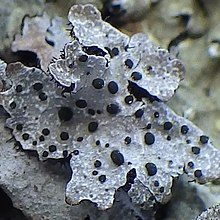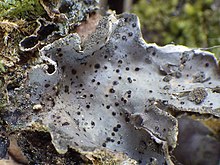| Abrothallus | |
|---|---|

| |
| parasitic Abrothallus parmeliarum on Parmelia saxatilis | |
| Scientific classification | |
| Domain: | Eukaryota |
| Kingdom: | Fungi |
| Division: | Ascomycota |
| Class: | Dothideomycetes |
| Order: | Abrothallales Pérez-Ort. & Suija (2013) |
| Family: | Abrothallaceae Pérez-Ort. & Suija (2013) |
| Genus: | Abrothallus De Not. (1845) |
| Type species | |
| Abrothallus bertianus De Not. (1849) | |
| Synonyms | |
Abrothallus is a genus of lichenicolous (lichen-dwelling) fungi. It is the only genus in the monotypic family Abrothallaceae, which itself is the sole taxon in the order Abrothallales.
Taxonomy
The genus was circumscribed by the Italian botanist Giuseppe De Notaris in 1849. The classification of the genus in either family or order was uncertain until molecular phylogenetic analysis revealed the group as an independent lineage in the class Dothideomycetes. Both the family and the order were circumscribed in 2013 by Sergio Pérez-Ortega and Ave Suija.
In 2012 Mikhail Zhurbenko proposed the genus Epinephroma to contain E. kamchatica; later analysis showed it to be the anamorph of an Abrothallus species, and now Epinephroma is placed in synonymy with Abrothallus. Other synonyms are Abrothallomyces, Phymatopsis, and Pseudo-lecidea.
Description
There are several morphological characteristics help define the genus Abrothallus. These include: spherical (or nearly so) ascomata without a margin or well-defined edge that are sometimes dusted with golden or green pruina; bitunicate asci (i.e., with two functional ascal wall layers) that have four to eight ascospores; brown, 2- to 4-celled, warted asymmetric ascospores; paraphyses that are ramified-anastomosed; and the presence of an epihymenium (the uppermost layer of the hymenium) with granulose pigments that often dissolve in potassium hydroxide.
Species

As of October 2024, Species Fungorum (in the Catalogue of Life) accepts 44 species of Abrothallus:
- Abrothallus acetabuli Diederich (1990) – parasitic on Parmelia acetabulum; from Europe
- Abrothallus altoandinus Flakus, Etayo & Rodr.Flakus (2023)
- Abrothallus boomii Pérez-Ort. & Suija (2015)
- Abrothallus brattii (S.Y.Kondr.) Suija & Pérez-Ort. (2015)
- Abrothallus bryoriarum Hafellner (1994)
- Abrothallus caerulescens I.Kotte (1909)
- Abrothallus canariensis Pérez-Ort., van den Boom & Suija (2015)
- Abrothallus cetrariae I.Kotte (1909)
- Abrothallus cladoniae R.Sant. & D.Hawksw. (1990)
- Abrothallus curreyi Linds. (1867) – New Zealand
- Abrothallus doliiformis Pérez-Ort. & Suija (2015)
- Abrothallus eriodermae Suija, Etayo & Pérez-Ort. (2015)
- Abrothallus ertzii Suija & Pérez-Ort. (2015)
- Abrothallus etayoi Pérez-Ort. & Suija (2015)
- Abrothallus granulatae Wedin (1994) – parasitic on Pseudocyphellaria granulata; from Argentina
- Abrothallus halei Pérez-Ort., Suija, D.Hawksw. & R.Sant. (2010) – parasitic on Lobaria quercizans and L. pulmonaria; from Europe and North America
- Abrothallus heterodermiicola Etayo & F.Berger (2017)
- Abrothallus hypotrachynae Etayo & Diederich (2002)
- Abrothallus kamchatica (Zhurb. & Stepanch.) Pérez-Ort. & Suija (2015)
- Abrothallus lobariae (Diederich & Etayo) Diederich & Ertz (2018)
- Abrothallus macrosporus Etayo & R.Sant. (2010) – South America
- Abrothallus microspermus Tul. (1852)
- Abrothallus nephromatis Suija & Pérez-Ort. (2015)
- Abrothallus niger Etayo (2017) – Ecuador
- Abrothallus parmeliarum (Sommerf.) Arnold (1874)
- Abrothallus parmotrematis Diederich (2011)
- Abrothallus peyritschii (Stein) I.Kotte (1909)
- Abrothallus pezizicola Diederich & R.C.Harris (2003)
- Abrothallus prodiens (Harm.) Diederich (1989)
- Abrothallus prodiens (Harm.) Clauzade, Diederich & Cl.Roux (1989)
- Abrothallus psoromatis (Zhurb. & U.Braun) Diederich & Zhurb. (2018)
- Abrothallus puntilloi Brackel (2016)
- Abrothallus ramalinae Diederich (2017) – Seychelles
- Abrothallus santessonii (D.Hawksw.) A.Suija, D.Hawksw. & Pérez-Ort. (2018)
- Abrothallus secedens Wedin & R.Sant. (1994) – commensalistic on species of Pseudocyphellaria; from Argentina and Kenya
- Abrothallus stereocaulorum Etayo & Diederich (2002)
- Abrothallus stictarum Etayo (2002) – Colombia
- Abrothallus stroblii Hafellner (2008)
- Abrothallus subhalei Etayo, Flakus & Kukwa (2019)
- Abrothallus suecicus (Kirschst.) Nordin (1964)
- Abrothallus teloschistis Brackel, Pérez-Ortega & Suija (2015)
- Abrothallus tetrasporus (Etayo & Osorio) Etayo, Flakus & Rodr.Flakus (2023)
- Abrothallus tulasnei M.S.Cole & D.Hawksw. (2001) – parasitic on Xanthoparmelia somloensis; from Canada
- Abrothallus usneae Rabenh. (1861)
- Abrothallus welwitschii Mont. (1856)
References
- ^ "Synonymy: Abrothallus De Not., Abrothallus: 1 (1845)". Species Fungorum. Retrieved 25 March 2021.
- Wijayawardene, Nalin; Hyde, Kevin; Al-Ani, Laith Khalil Tawfeeq; Somayeh, Dolatabadi; Stadler, Marc; Haelewaters, Danny; et al. (2020). "Outline of Fungi and fungus-like taxa". Mycosphere. 11: 1060–1456. doi:10.5943/mycosphere/11/1/8. hdl:11336/151990.
- De Notaris, G. (1846). "Frammenti lichenografici di un lavoro inedito". Giornale Botanico Italiano (in Italian). 2 (1): 174–224 (see p. 192).
- Pérez-Ortega, Sergio; Suija, Ave; Crespo, Ana; de los Ríos, Asunción (2013). "Lichenicolous fungi of the genus Abrothallus (Dothideomycetes: Abrothallales ordo nov.) are sister to the predominantly aquatic Janhulales". Fungal Diversity. 64 (1): 295–304. doi:10.1007/s13225-013-0269-y.
- Zhurbenko, M.P.; Himelbrant, D.E.; Kuznetsova, E.S.; Stepanchikova, I.S. (2012). "Lichenicolous fungi from the Kamchatka Peninsula, Russia". The Bryologist. 115 (2): 295–312. doi:10.1639/0007-2745-115.2.295.
- ^ Suija, Ave; De los Ríos, Asunción; Pérez-Ortega, Sergio (2015). "A molecular reappraisal of Abrothallus species growing on lichens of the order Peltigerales". Phytotaxa. 195 (3): 201–226. doi:10.11646/phytotaxa.195.3.1.
- Suija, Ave (2006). "Variation of morphological characters in the lichenicolous ascomycete genus Abrothallus" (PDF). Annales Botanici Fennici. 43: 193–204.
- "Abrothallus". Catalogue of Life. Species 2000: Leiden, the Netherlands. Retrieved 30 October 2024.
- Diederich, Paul (1990). "New or interesting lichenicolous fungi 1. Species from Luxembourg". Mycotaxon. 37: 297–330.
- Senanayake, Indunil C.; Rossi, Walter; Leonardi, Marco; Weir, Alex; McHugh, Mark; Rajeshkumar, Kunhiraman C.; et al. (2023). "Fungal diversity notes 1611–1716: taxonomic and phylogenetic contributions on fungal genera and species emphasis in south China". Fungal Diversity. 122 (1): 161–403. doi:10.1007/s13225-023-00523-6.
- Hafellner, J. (1994). "Beiträge zu einem Prodromus der lichenicolen Pilze Österreichs und angrenzender Gebiete. I. Einige neue oder seltene Arten". Herzogia (in German). 10: 1–28. doi:10.1127/herzogia/10/1994/1.
- ^ Kotte, I. (1909). "Einige neue Fälle von Nebensymbiose (Parasymbiose)". Centralblatt für Bakteriologie und Parasitenkunde. 2. Abth. (in German). 24: 74–93.
- Hawksworth, D.L. (1990). "Notes on British lichenicolous fungi: VI". Notes from the Royal Botanical Garden Edinburgh. 46: 391–403.
- Lindsay, W.L. (1867). "Observations on new lichens and fungi collected in Otago, New Zealand". Transactions of the Royal Society of Edinburgh. 24 (2): 407–456. doi:10.1017/S0080456800018640.
- ^ Wedin, Mats (1994). "New and noteworthy lichenicolous fungi from southernmost South America". The Lichenologist. 26 (3): 301–310. Bibcode:1994ThLic..26..301W. doi:10.1006/lich.1994.1022.
- Suija, Ave; Pérez-Ortega, Sergio; Hawksworth, David L. (2010). "Abrothallus halei (Ascomycota, incertae sedis), a new lichenicolous fungus on Lobaria species in Europe and North America". The Lichenologist. 43 (1): 51–55. doi:10.1017/S002428291000054X.
- ^ Etayo, Javier (2017). Hongos liquenícolas de Ecuador. Opera Lilloana. Vol. 50. pp. 65, 70.
- ^ Etayo, Javier (2002). Aportación al conocimiento de los hongos liquenícolas de Colombia. Bibliotheca Lichenologica. Vol. 84. Berlin; Stuttgart: J. Cramer. p. 19. ISBN 978-3-443-58063-6.
- Etayo, J. (2010). "Hongos liquenícolas de Perú Homenaje a Rolf Santesson". Bulletin de la Société Linnéenne de Provence. 61: 2–46.
- Tulasne, L.-R. (1852). "Mémoire pour servir à l'histoire organographique et physiologique des Lichens". Annales des Sciences Naturelles Botanique. 3 (in French). 17: 5–128.
- Diederich, Paul (2011). "Description of Abrothallus parmotrematis sp. nov. (lichenicolous Ascomycota)". Bulletin de la Société des Naturalistes Luxembourgeois (in French). 112: 25–34.
- Diederich, Paul (2003). "Neue Arten und neue Funde von amerkanischen lichenicolen Pilzen". Herzogia (in German). 16: 41–90.
- Brackel, W.V.; Puntillo, D. (2016). "New records of lichenicolous fungi from Calabria (southern Italy), including a first checklist". Herzogia. 29 (2/1): 277–306. doi:10.13158/heia.29.2.2016.277.
- Diederich, P.; Lücking, R.; Aptroot, A.; Sipman, H.J.M.; Braun, U.; Ahti, T.; Ertz, D. (2017). "New species and new records of lichens and lichenicolous fungi from the Seychelles". Herzogia. 30 (1): 182–236. doi:10.13158/heia.30.1.2017.182.
- Hafellner, J.; Herzog, G.; Mayrhofer, H. (2008). "Zur Diversität von lichenisierten und lichenicolen Pilzen in den Ennstaler Alpen (Österreich: Steiermark, Oberösterreich)". Mitteilungen des Naturwissenschaftlichen Vereins für Steiermark (in German). 137: 131–204.
- Flakus, Adam; Etayo, Javier; Miadlikowska, Jolanta; Lutzoni, François; Kukwa, Martin; Matura, Natalia; Rodriguez-Flakus, Pamela (2019). "Biodiversity assessment of ascomycetes inhabiting Lobariella lichens in Andean cloud forests led to one new family, three new genera and 13 new species of lichenicolous fungi". Plant and Fungal Systematics. 64 (2): 283–344. doi:10.2478/pfs-2019-0022.
- Cole, M.S.; Hawksworth, D.L. (2001). "Lichenicolous fungi, mainly from the USA, including Patriciomyces gen. nov". Mycotaxon. 77: 305–338.
- Montagne, J.P.F.C. (1851). "Cryptogamia Guyanensis seu plantarum cellularium in Guyana gallica annis 1835–1849 a cl. Leprieur collectarum enumeratio universalis". Annales des Sciences Naturelles Botanique (in Latin). 16: 47–81.
| Taxon identifiers | |
|---|---|
| Abrothallus |
|
| Abrothallaceae | |
| Abrothallales | |